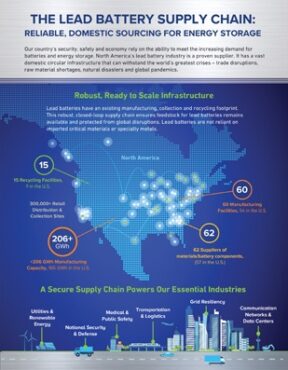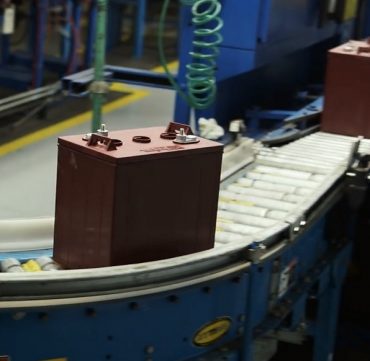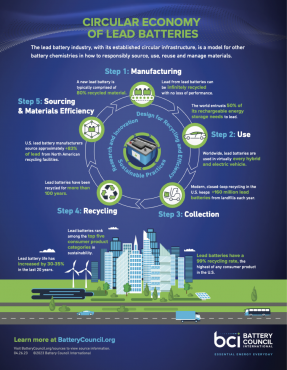North American Supply Chain Models Reliability, Resiliency Essential for Economic Recovery
WASHINGTON – January 27 – The world is facing simultaneous crises that have disrupted supply chains globally. But North America’s lead battery industry is a proven exception, confirmed by information released today from Essential Energy Everyday (EEE), an initiative led by Battery Council International (BCI).
A new video and infographic show how lead batteries’ vast, domestic, circular infrastructure can withstand – and is withstanding – the world’s greatest crises, from trade disruptions and natural disasters to a global pandemic.
As the new Biden Administration looks to advance battery technology, the shovel-ready lead battery industry is poised to help meet the nation’s growing energy needs. In addition to being a part of the “Build Back Better Recovery Plan,” the industry expects to participate in the Buy American program expanded through an Executive Order on Monday.
“The lead battery industry, with its strong domestic supply chain, is ideally positioned to rapidly deliver on President Biden’s promise to have American jobs support the nation’s post-COVID economic recovery, and also to ensure America’s global leadership on technological innovation and a green economy infrastructure,” said Roger Miksad, BCI executive vice president and general counsel. “Lead batteries are used in transportation, data storage, renewable energy and other vital functions – and more than 90% of the batteries needed in the U.S. are sourced and manufactured right here in the U.S.”
Ensuring Critical Materials are Available for Critical Infrastructure
The industry is lauded for its closed-loop supply chain and sustainability track record. It has become a model for other battery technologies and industries. The events of 2020 reinforced another narrative: Lead battery circularity within North America is ensuring a reliable supply chain for lead battery manufacturers that is not dependent on imports.
In contrast, some critical metals used in lithium-ion batteries, such as lithium, cobalt and graphite, are scarce, not currently mined in large quantities, or are mined in only a few countries whose trade policies could limit availability and impact prices.
Sharing the facts about lead battery sourcing security couldn’t be timelier, according to Miksad.
“As the need for grid resiliency, electrification and climate change mitigation grows, so does the need for safe, reliable energy storage. One recent survey reported that global battery demand is estimated to grow 110% over the next decade.”
The infographic shares that U.S. manufacturers source approximately 73% of the needed lead from domestic lead battery recycling. As 2020 has shown, the ability to secure domestic feedstock of critical materials for lead battery manufacturers is beyond important. Our country’s security, safety and economy rely on it.
Infographic and Video Highlights
The video titled “Lead Battery’s Domestic Supply Chain Remains Resilient Through Crises,” and infographic use powerful imagery and data points to convey why lead batteries are a proven, reliable supplier for energy storage:
- The lead battery industry is robust and scalable. A map of North America calls out the number of existing facilities for lead battery manufacturing (50), distribution and collection (250,000+), and recycling (13). Also included are the number of U.S. jobs supported by the lead battery industry (92,000) and large number of research projects (more than 50) aimed at advancing innovation to create a next-generation lead battery to support future U.S energy needs.
- Lead batteries power essential industries. Without lead batteries, our daily lives would grind to a halt. A city graphic points to a few of the key industries where lead batteries are essential, including national security and defense, grid resiliency, and our communication and data networks.
- Lead batteries have a circular Infrastructure that provides reliable, domestic material sourcing. A circular infrastructure diagram offers key data points that explain why lead batteries are a model of a successful, closed-loop, domestic circular economy. For example, lead batteries have a 99% recycling rate, compared to 5% for lithium-ion. The three main components of lead batteries (lead, plastic and electrolytes) are also 100% recyclable.
Lead Batteries: The Future of Energy Storage
In publishing the new materials, the industry demonstrates how domestic sourcing and, thus, supply chain security, make lead batteries essential to the future of U.S. energy storage.
An August 2020 issue of Science Magazine agreed, saying “ … perhaps the most unutilized potential of lead-acid batteries is electric grid storage, for which the future market is estimated to be on the order of trillions of dollars …”
Learn More at Essential Energy Everyday
Essential Energy Everyday exists to increase awareness of the critical importance of lead batteries in powering our daily lives. It encourages continued investment in sustainable lead battery technology to store and provide energy on demand. The initiative is supported by Battery Council International, the global trade association that represents the lead battery and recycling industries.
About Battery Council International
Battery Council International is the North American trade association representing the lead-based battery manufacturing, supply, recycling and distribution companies. For more information, visit Battery Council International.








